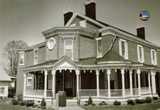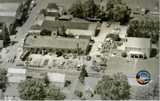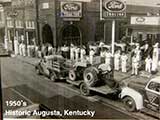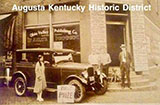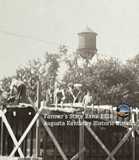
 |
 |
|
| C & O Railroad Depot | from the Ripley Bee, April 3, 1879 | |

Highland (VA) Recorder, February 10, 1893
It says here there's going to be a railroad from Augusta to Georgetown, Ohio
 |
 |
 |
| John S. Bradley's | Parkview Hotel, Augusta |
Buckle Factory in Augusta |
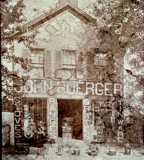 |
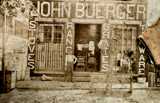 |
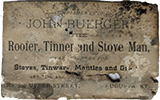 |
| John Buerger: Roofer, Tinner and Stove Man, 100 Upper Street Thanks to Rodney Pratt for these. |
||
Hotel Fire, Main and Riverside, Augusta
 |
 |
 |
 |
| Ad for F. A. Neider's Peerless Foot Rest, 1913 | Ad for F. A. Neider's various Fasteners, 1913 | Ad for F. A. Neider's Double Headed Form Nail, 1910 | Ad for F. A. Neider's Peerless Curtain Fastener, 1907 |
 |
 |
 |
| c. 1910 | 1897 | 1947 |
The F. A. Neider Company, Automobile and Carriage Trimming Factory, Augusta
More about the company, in 1897, is here.
The 1909 Sanborn Fire Map locating Neider is here.
Info on accessing the entire series of Augusta Fire maps is here.
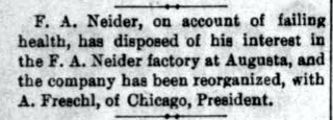
Maysville's Evening Bulletin, August 14, 1903
The Bradford Hotel on Riverview
A flood scene, likely the flood of 1907 or 1913
Michael Sells advertised his gun making business and his wool carding business in 1835.
A later ad for his blacksmithing/gun making is here.
In 1825, Louis Weimer advertised a “house of entertainment,” by which he likely meant brothel.
![]()
The Daily Commonwealth, March 27, 1883
 |
 |
| c. 1910 | c. 1947 |
| L. V. Marks and Company, Shoe Factory, Augusta | |
Funeral Home, former Post Office, 4th and Bracken
From a Facebook post by The Augusta Historical District
 |
 |
| Baker Wine Cellar, near Augusta, 1911. | Inside the Winery photo by Bronze Photographer |
| The Abraham Baker Wine Cellar was a safe house for civilians during the Civil War fighting in Augusta. The walls inside the cellar (a 40 by 100 foot room with a 37 foot tall ceiling) are 36 inches thick; some stones are 3 by 2 feet, and a foot thick, mostly dug nearby by slaves. | |
| The Baker Winery is on the National Register of Historical Places. The NRHP application has pictures, a history, and maps. (pdf) There's also an expanded footprint application. (pdf) | |

The Highland Weekly News (Hillsboro), November 17, 1859
Evan Griffith's Grocery is on the National Register of Historical Places. (pdf)
 |
 |
W. J. Rankin's Store, Augusta
|
The Bracken Chronicle. |
A new newspaper comes to Augusta. In 1832.
The Chronicle's slogan, from 1936
| “The first number of the Bracken County Chronicle, a weekly paper, published at Augusta, has been received. It is devoted to literature, education and general news, and presents a credible appearance. Bracken county should extend to it a cordial support. ” from the Courier-Journal, September 7, 1869 |

 |
| We know that there were at least these newspapers in pre-Civil War Augusta. The dates represent issues that have been found, or referenced, not a start or stop date. The division symbols indicate also publishing after the war. W is weekly. |
Premium Cigar Factory, Augusta
Thanks to Bill and Judy Cooper for this one.
Aerial view of Richey Sales Co.
From a Facebook post by The Augusta Historical District
 |
 |
| c. 1947 | 1936 |
| Augusta Motor Co. The employee list is here. | |

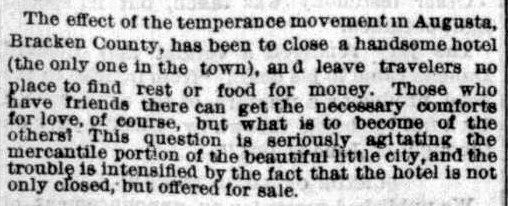
Cincinnati Commercial, June 17, 1874
| The source of the bricks for the new hotel in 1869: Ripley. And some Ripley citizens weren't happy. | |
The Augusta Electric Light & Gas Company is legally established in 1890. |
An ad from the hotel in Augusta. From 1833. Here. |
| “We are indebted to Col. L. J. Bradford, of Bracken county, for a supply of excellent Augusta wine, from the vineyard of Dr. J. Taylor Bradford, near Augusta, Ky. The State Fair of Kentucky and New York awarded to this wine the highest premium, and it commands as high a price as any wine manufactured in the United States. It is a very superior article, of excellent flavor, and is the pure juice of the grape.” from the Louisville Daily Courier, November 22, 1859 | |
“The wire mattress factory or Ritter & Hook is now in full blast in Augusta.” from Covington's Daily Commonwealth, March 27, 1883 |
The State's 1916-1917 Labor reports listed these businesses in Augusta. |

 |
 |
 |
Business District, |
Pompelly's, Augusta |
Jones Livery Stable, Augusta |
Main and Second
From a Facebook posts by Augusta Kentucky Historic District.
 |
 |
This picture is from the Bracken County |
This scene, too, is from the Bracken County |
| “The Augusta ferryboat, Whisper, sank in about ten feet of water while tied to the bank at that place
Saturday morning about 4 o'clock. The craft had sprung a leak during the night and sank so suddenly that the engineer,
who was sleeping on the boat, barely escaped.” from the Maysville Bulletin, Feb. 28, 1908. |
The book business in 1816 Augusta |
| Messrs. Armstrong and Taylor were Augusta gun makers. Read about their breech-loading rifles here. (pdf) | |
| In 1829, Augusta's John C. Andrews published Old Christopher's Almanac, or Augusta Magazine Calendar, for the year of our Lord, 1830, being the second after bissextile [leap year] and after the fourth of July, the fifty-fifth year of American Independence. Calculated by Leonard O'Neal, Esq. Philom. For the Meridian of Augusta, but will serve without any sensible variation for all the stern states. Filet Containing also the maxims and advice of Poor Richard, with other useful and interesting matter. [woodcut of beehive], Augusta, Ky. Printed and Published by John C. Andrews, And sold by the principal merchants and traders, 1829. | |
| “Augusta, Ky., Dec. 12. - The boiler in the molding department of the Augusta stove and range works exploded and injured six men.
James Brothers and Harry Insley were seriously hurt, while Samuel and Kirk Wood, James Gates and Gus Shaffenberger were cut and bruised.
The boiler was blown through the side of the building and across the C. & O. tracks, a distance of 300 feet. The building was badly
damaged and the loss will amount to several thousand dollars. The foundry is owned and operated by E. H. Heuenfeld & Co. of
Cincinnati.” from the Maysville Evening Bulletin, December 12, 1903 |
“Augusta, the commercial center of this famous tobacco growing country is beautifully situated on the south bank of the Ohio river 42 miles above Cincinnati; it has eight tobacco warehouses, including the famous Mason Warehouse whose receipts alone, since June 1st, have amounted to 655 hhds [hogsheads]; it has four cigar factories, as follows: The Great Western, G. W. Winter, proprietor, manufactures the popular ætna, Reform, Challenger, Diamond, and other brands, has a capacity of 15,000 cigars per month; the Grand King, W. J. Mingna & Co., proprietors, manufactures the Grand King, Racket, Gold Basis, Little Queen and numerous other popular brands, has a capacity of 15,000 cigars per month; M. Hartman, the popular manufacturer of the famous Acme and Pearl; J. W. Roden & Co., manufacturers of the popular Bonanza and Little Giant.” From a Covington newspaper, The Ticket, August 22, 1876 |
Dr. C. M. White moves to town in 1869. Says he can cure consumption.
Farmers State Bank construction scene, 1928
From a Facebook post by The Augusta Historical District
 |
 |
 |
Second and Upper Street, the Augusta German Bank |
||
| Incorporation papers (pdf) of the Augusta Liberty Bank, 1918. | Incorporation papers (pdf) of the Farmers State Bank of Augusta, 1926 | Incorporation papers (pdf) of the merged Farmers Liberty Bank, 1958. Story here. | Incorporation papers (pdf) from 1994, the end of local ownership |
| Incorporators, 1918 | Incorporators, 1926 | Incorporators, 1958 |
The Augusta Deposit Bank was chartered by the Kentucky Legislature back in 1853. Read the Act here.
The First National Bank of Augusta went into voluntary liquidation on June 20, 1895.
 |
 |
| Farmers' National Bank of Augusta notes, from the days when national banks could have their own currency. More on the practice is here.(Wikipedia) Farmers' National went into voluntary liquidation on August 15, 1926. | |
The banking house of Allen, Harbeson & Co is chartered in Augusta, 1874.
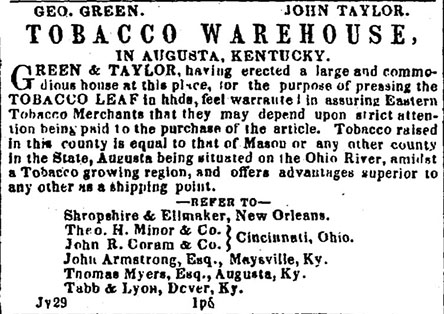
Atlas (Boston), July 29, 1843




